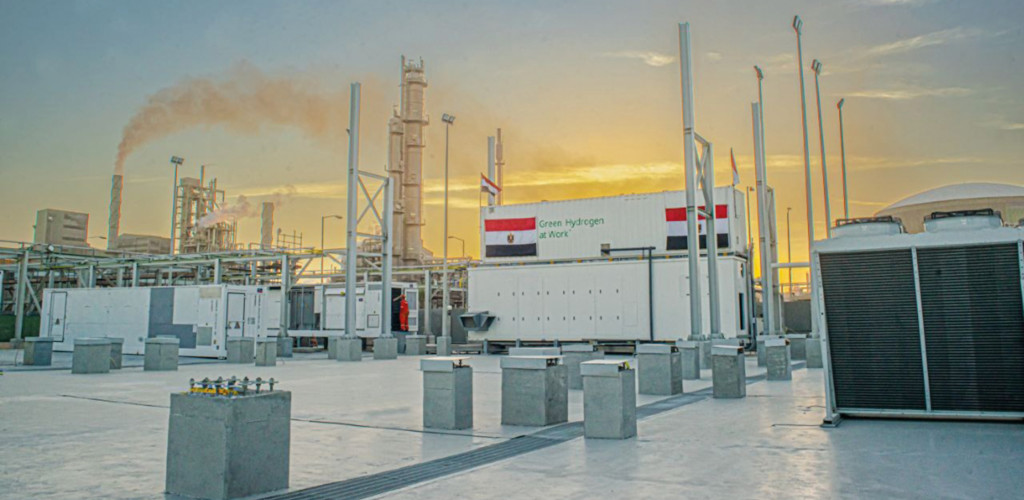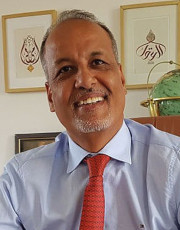Green Fuel to Catalyze Region’s Project Demand
 By Liesl Venter
By Liesl Venter
From Issue 6 of Breakbulk Magazine, we report on how regional governments in North Africa are forming alliances and smashing down barriers to facilitate the buildout of world-scale green hydrogen construction projects.
World trade is gearing up for a hydrogen revolution. A total of 660 million tons is required for global carbon neutrality by 2050. This shift towards hydrogen as a significant commodity marks a colossal economic opportunity on the horizon. For North Africa, this news couldn’t be more welcome. With its vast renewable energy resources, the region is primed to play a pivotal role in this burgeoning hydrogen market.
 “Green hydrogen is not just a game-changer for the project sector, but for North Africa,” said Mohamed Abdellahi Yaha, owner and CEO of Maurilog, an integrated logistics service provider that has been servicing the oil and energy sector in North Africa for the past 20 years. “It holds incredible economic promise, but also positions North Africa as a vital player in the global effort to achieve sustainability goals, underscoring the region’s strategic significance in the clean energy transition.”
“Green hydrogen is not just a game-changer for the project sector, but for North Africa,” said Mohamed Abdellahi Yaha, owner and CEO of Maurilog, an integrated logistics service provider that has been servicing the oil and energy sector in North Africa for the past 20 years. “It holds incredible economic promise, but also positions North Africa as a vital player in the global effort to achieve sustainability goals, underscoring the region’s strategic significance in the clean energy transition.”
Produced through a process known as electrolysis, using renewable energy sources like solar or wind power to split water molecules into hydrogen and oxygen, its versatility and potential to replace carbon-intensive fuels make it a cornerstone in the global effort to combat climate change.
“North Africa has plenty of water, sun, space, and wind. When you add in the demand from the market, it’s clear this region is on the brink of significant change,” Yaha said. “The conflict between Russia and Ukraine has highlighted Europe’s urgent need for energy independence. These nations are seeking ways to reduce their dependence on Russian gas and exploring alternative options.
When we factor in the pressing issue of climate change and the fact that green hydrogen, unlike today’s fossil fuels, doesn’t emit harmful gases into the atmosphere when used, thus contributing to the fight against global warming, it becomes clear that countries such as Mauritania, Morocco, Egypt, and Tunisia are poised to emerge as leaders in this crucial transition.”
A recent study published by Deloitte confirms the intrinsic role countries in the north of Africa will play. In its 2023 global green hydrogen outlook, the consultancy stated that by 2050, North Africa, Australia, North America, and the Middle East will collectively account for 45 percent of global hydrogen production and 90 percent of trade. North Africa has the highest export potential at US$110 billion per year, followed by North America (US$63 billion), Australia (US$39 billion) and the Middle East (US$20 billion).
Yaha underscored that the already established pipeline networks are crucial in enhancing North Africa’s green hydrogen potential. Countries across the region are increasingly recognizing their capacity to seize this opportunity. Egypt, Morocco, Mauritania, Kenya, South Africa, and Namibia stand as founding members of the Africa Green Hydrogen Alliance. Together, those nations are committed to strengthening their cooperation to accelerate the growth of green hydrogen projects throughout the continent.
Their collaborative efforts encompass developing public policies and regulatory frameworks, building capacity, securing financing, and addressing certification requirements, all to facilitate the production of green hydrogen for domestic consumption and exportation.
A Transformative Path Forward
Throughout history, numerous African nations have confronted daunting issues like poverty, political instability, and restricted access to education and healthcare. However, green hydrogen has ushered in a newfound wave of optimism and purpose that is now sweeping across the continent. Countries are stepping up their ambitions, embracing a new era of growth and inclusivity. These nations, once seen as not dreaming big enough, are now championing change and setting their sights on a brighter future.
 “Africa has the best renewable energy in the world, and scaling up production of green hydrogen can transform access to low-cost electricity and clean water,” said Ambroise Fayolle, vice president of the European Investment Bank, which is working closely with countries in North Africa to harness renewable energy potential to produce low-cost green hydrogen at scale.
“Africa has the best renewable energy in the world, and scaling up production of green hydrogen can transform access to low-cost electricity and clean water,” said Ambroise Fayolle, vice president of the European Investment Bank, which is working closely with countries in North Africa to harness renewable energy potential to produce low-cost green hydrogen at scale.
The bank’s report, titled Africa’s Remarkable Green Hydrogen Potential, presents clear opportunities to revolutionize access to green energy and clean water within the continent and the wider world. It outlines what can be accomplished and the necessary steps to achieve these goals. The research outlines three essential conditions for producing 50 million tons of green hydrogen in Africa by 2035.
Firstly, national planning, regulation, and incentive programs must be established to attract private sector investments. Second, pilot projects must demonstrate successful green hydrogen generation, storage, distribution, and utilization at demonstration and commercial scales. Third, market-oriented collaborations are required to create substantial domestic and international demand for green hydrogen. Additionally, increased cooperation is needed to design, finance, construct, and operate green hydrogen production, storage, and distribution infrastructure.
According to the study, large-scale green hydrogen generation will enable Africa to supply 25 million tons of green hydrogen to global energy markets, equivalent to 15 percent of current gas used in the European Union.
“The advantages of green hydrogen are evident. Governments are realizing they stand to gain a lot with minimal risk. Although these countries are competitors in North Africa, they increasingly recognize the need for cooperation. There’s room for everyone in this vast market, and the demand knows no bounds. Everyone will benefit. It’s simply a matter of making it a reality,” Yaha said.
Navigating the Obstacles
While North Africa’s exceptional geographical advantages, including vast deserts and abundant sunlight, make it an ideal location for large-scale green hydrogen production, harnessing its hydrogen potential comes with its fair share of challenges.
Infrastructure development is at the forefront of these challenges, which demands significant investments to establish the essential components for green hydrogen production, storage, and transportation. This encompasses the construction of solar and wind farms, electrolysis facilities, and hydrogen pipelines. Additionally, addressing regulatory frameworks, a process that can be time-consuming, in Africa is essential.
Regional governments must establish clear and supportive regulations to attract private investments and maintain a stable business environment for green hydrogen projects. Another obstacle to overcome is education and workforce development. The training and developing of a skilled workforce capable of operating and maintaining green hydrogen infrastructure will be vital for progress.
However, several governments are already taking proactive measures in this regard. Egypt, for instance, is forging ahead with its ambitions to become a green hydrogen producer and has solidified multiple agreements with international companies. In August of this year, Egypt inked a preliminary deal with Ocior, an Indian renewable energy firm, committing to invest US$4 billion in green projects. Furthermore, the nation has signed at least seven additional Memoranda of Understanding with companies from Saudi Arabia, China, Germany, Britain, and India, all for green hydrogen initiatives.
In recent months, the Egyptian Cabinet approved the establishment of the National Council for Green Hydrogen, aimed at promoting green investments and implementing the national green hydrogen strategy. This Council will also oversee the review of all legislation and regulations related to green hydrogen and its derivatives.
As part of this comprehensive strategy, Egypt has set its sights on producing green hydrogen at the world’s lowest cost by 2050, targeting a remarkable US$1.7 per kilogram, and aspires to capture an 8 percent share of the global hydrogen market, as stated by government officials.
Morocco has also unveiled its national strategy outlining its path to becoming a global player in the green hydrogen industry. It plans to commence production and exports as early as next year. The government aims to achieve a 52 percent share of renewable energy in its total capacity by 2030, and it is preparing for significant investments totaling at least US$60 billion across approximately 454 projects focused on green hydrogen and ammonia.
Meanwhile, Tunisia has set an ambitious target of manufacturing 8.3 million tonnes of green hydrogen annually by 2050, demonstrating its commitment to this sustainable energy source. Additionally, Mauritania has announced plans to establish itself as a green hydrogen hub in North Africa, positioning the country at the forefront of this burgeoning industry in the region.
‘Positive Signs’ for Projects
Rafael Vicens, managing director Iraq and head of global projects and industry solutions for the Middle East & Africa at DB Schenker, noted that the demand for infrastructure is a positive sign for the project sector. “Considering the substantial investments made by countries like Mauritania and Senegal, there is a promising outlook for project-related work. These developments are progressing so rapidly that there is a risk of insufficient assets to support these projects when the time arrives.”
Vicens and Yaha highlighted that logistics operators are facing a delicate balancing act. They emphasized the importance of being prepared for the impending project boom but caution against acting too early or too late. The challenge lies in aligning readiness with the pace of developments in the region.
“Undoubtedly, the demand for infrastructure to transport and export hydrogen will surge. We don’t have much congestion at the moment, but it will come if the hydrogen boom takes off,” Yaha said.
There are also concerns that the hydrogen industry’s rapid growth may outpace supporting infrastructure development. “Of course, the transport and storage of hydrogen requires specialized equipment and facilities. If these logistics elements are not expanded concurrently with the industry’s growth, it can lead to bottlenecks and congestion.”
However, according to Vicens, the advantages outweigh the drawbacks as operators prepare to meet the increasing demand. Yaha added that North Africa is in a favorable position to seize the most incredible economic opportunity of our time while significantly contributing to the battle against climate change. As the demand for project logistics surges due to the increasing trade in green hydrogen, this region is poised for substantial growth.
Read more about Mauritania’s hydrogen potential.
TOP PHOTO: Africa's first integrated green hydrogen plant. CREDIT: Scatec
